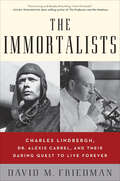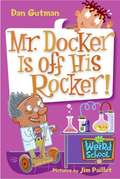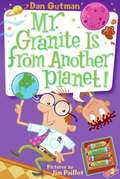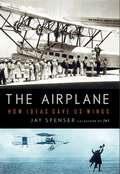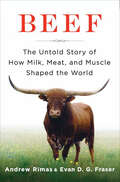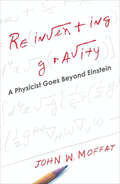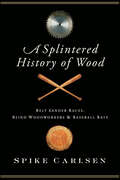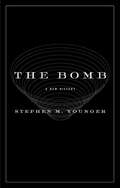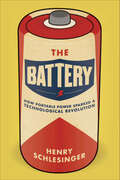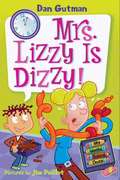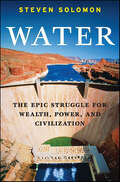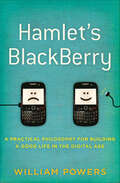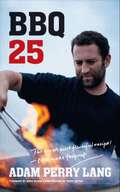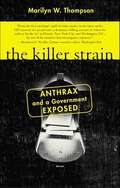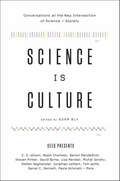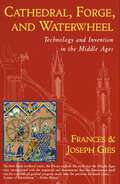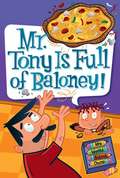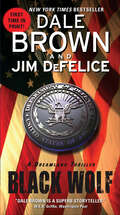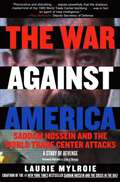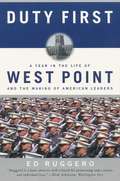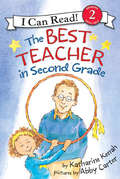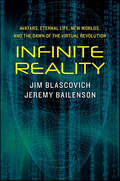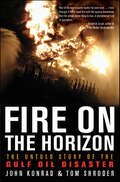- Table View
- List View
The Immortalists: Charles Lindbergh, Dr. Alexis Carrel, and Their Daring Quest to Live Forever
by David M. FriedmanHis historic career as an aviator made Charles Lindbergh one of the most famous men of the twentieth century, the subject of best-selling biographies and a hit movie, as well as the inspiration for a dance step—the Lindy Hop—that he himself was too shy to try. But for all the attention lavished on Lindbergh, one story has remained untold until now: his macabre scientific collaboration with Dr. Alexis Carrel. This oddest of couples—one a brilliant Nobel Prize-winning surgeon turned social engineer, the other a failed dirt farmer turned hero of the skies—joined forces in 1930 driven by a shared and secret dream: to conquer death and attain immortality.Part Frankenstein, part The Professor and the Madman, and all true, The Immortalists is the remarkable story of how two men of prodigious achievement and equally large character flaws challenged nature's oldest rule, with consequences—personal, professional, and political—that neither man anticipated.
Mr. Docker Is Off His Rocker! (My Weird School #10)
by Dan Gutman Jim Paillot<P>Something weird is going on! <P>Mr. Docker must be a mad scientist! He does nutty experiments and he has an evil, demented, cackling laugh. Plus he invented a car that runs onto potatoes. Mr. Docker is the weirdest science teacher ever! Is he trying to take over the world?
Mr. Granite Is from Another Planet! (My Weird School Daze #3)
by Dan Gutman Jim PaillotIt's the start of a new school year, and A.J.'s third-grade teacher, Mr. Granite, is out of this world! He's a supergenius who talks weird, acts weird, and looks weird. He knows everything. Is he a computer posing as a person, or does he come from another planet?
The Airplane: How Ideas Gave Us Wings
by Jay SpenserIn this entertaining history of the jetliner, Jay Spenser traces aviation's challenges from the outset, and follows the flow of the simple yet powerful ideas that led us to defy gravity. Here are the pioneers—innovators such as Otto Lilienthal, Igor Sikorsky, Louis Blériot, Hugo Junkers, and Jack Northrop—whose amazing contributions collectively solved the puzzle of flight. Along the way, Spenser demystifies the modern jetliner, examining the airplane from wings to flight controls to fuselages to landing gear, to show how each part came into being and evolved over time. And finally The Airplane addresses the future of aviation, outlining the breathtaking possibilities that await us tomorrow, many miles above the earth.Who were aviation's dreamers, and where did they get their inspiration?How did birds, insects, marine mammals, and fish help us to fly?How did the bicycle beget the airplane, and hot water heaters lead to metal fuselages?Who figured out how to fly without seeing the ground, enabling airline travel in all weather conditions?
Beef: The Untold Story of How Milk, Meat, and Muscle Shaped the World
by Andrew Rimas Evan D. FraserThe cow. The most industrious animal in the world. A beast central to human existence since time began, it has played a vital role in our history not only as a source of food, but also as a means of labor, an economic resource, an inspiration for art, and even as a religious icon. Prehistoric people painted it on cave walls; explorers, merchants, and landowners traded it as currency; many cultures worshipped it as a god. So how did it come to occupy the sorry state it does today—more factory product than animal?In Beef, Andrew Rimas and Evan D. G. Fraser answer that question, telling the story of cattle in its entirety. From the powerful auroch, a now extinct beast once revered as a mystical totem, to the dairy cows of seventeenth-century Holland to the frozen meat patties and growth hormones of today, the authors deliver an engaging panoramic view of the cow's long and colorful history.Peppered with lively anecdotes, recipes, and culinary tidbits, Beef tells a story that spans the globe, from ancient Mediterranean bullfighting rings to the rugged grazing grounds of eighteenth-century England, from the quiet farms of Japan's Kobe beef cows to crowded American stockyards to remote villages in East Africa, home of the Masai, a society to which cattle mean everything. Leaving no stone unturned in its exploration of the cow's legacy, the narrative serves not only as a compelling story but as a call to arms, offering practical solutions for confronting the current condition of the wasteful beef and dairy industries. Beef is a captivating history of an animal whose relationship with humanity has shaped the world as we know it, and readers will never look at steak the same way again.
Reinventing Gravity: A Physicist Goes Beyond Einstein
by John W. MoffatEinstein's gravity theory—his general theory of relativity—has served as the basis for a series of astonishing cosmological discoveries. But what if, nonetheless, Einstein got it wrong?Since the 1930s, physicists have noticed an alarming discrepancy between the universe as we see it and the universe that Einstein's theory of relativity predicts. There just doesn't seem to be enough stuff out there for everything to hang together. Galaxies spin so fast that, based on the amount of visible matter in them, they ought to be flung to pieces, the same way a spinning yo-yo can break its string. Cosmologists tried to solve the problem by positing dark matter—a mysterious, invisible substance that surrounds galaxies, holding the visible matter in place—and particle physicists, attempting to identify the nature of the stuff, have undertaken a slew of experiments to detect it. So far, none have.Now, John W. Moffat, a physicist at the Perimeter Institute for Theoretical Physics in Waterloo, Canada, offers a different solution to the problem. The capstone to a storybook career—one that began with a correspondence with Einstein and a conversation with Niels Bohr—Moffat's modified gravity theory, or MOG, can model the movements of the universe without recourse to dark matter, and his work challenging the constancy of the speed of light raises a stark challenge to the usual models of the first half-million years of the universe's existence. This bold new work, presenting the entirety of Moffat's hypothesis to a general readership for the first time, promises to overturn everything we thought we knew about the origins and evolution of the universe.
The Hungry Scientist Handbook
by Patrick Buckley Lily BinnsInventive, (mostly) edible DIY gadgets and projects guaranteed to captivate The Hungry Scientist Handbook brings DIY technology into the kitchen and onto the plate. It compiles the most mouthwatering projects created by mechanical engineer Patrick Buckley and his band of intrepid techie friends, whose collaboration on contraptions started at a memorable 2005 Bay Area dinner party and resulted in the formation of the Hungry Scientist Society--a loose confederation of creative minds dedicated to the pursuit of projects possessing varying degrees of whimsy and utility. Featuring twenty projects ranging from edible origami to glowing lollipops, cryogenic martinis to Tupperware boom boxes, the book draws from the expertise of programmers, professors, and garden-variety geeks and offers something to delight DIYers of all skill levels.
A Splintered History of Wood: Belt-Sander Races, Blind Woodworkers & Baseball Bats
by Spike CarlsenIn a world without wood, we might not be here at all. Without wood, we wouldn't have had the fire, heat, and shelter that allowed us to expand into the colder regions of the planet. If civilization somehow did develop, our daily lives still would be vastly different: there would be no violins, baseball bats, chopsticks, or wine corks. The book you are now holding wouldn't exist. At the same time, many of us are removed from the world where wood is shaped and celebrated every day. That world is inhabited by a unique assortment of eccentric craftsmen and passionate enthusiasts who have created some of the world's most beloved musical instruments, feared weapons, dazzling architecture, sacred relics, and bizarre forms of transportation. In A Splintered History of Wood, Spike Carlsen has uncovered the most outlandish characters and examples, from world-champion chainsaw carvers to blind woodworkers, the Miraculous Staircase to the Lindbergh kidnapping case, and many more, in a passionate and personal exploration of nature's greatest gift.
The Bomb: A New History
by Steven M. YoungerA former Los Alamos weapons designer shares “an indispensable guide to the science and strategy of nuclear weapons” (Booklist).From his years at Los Alamos and the Nevada Test Site to his meetings with nuclear arms experts in Moscow, former weapons designer Stephen M. Younger has witnessed firsthand the making of nuclear policy. With a deep understanding of both the technology and the politics behind nuclear weapons, he guides us from the Manhattan Project to the Cold War and into the present day, illuminating how nuclear weapons fit into our globalized, war-plagued world. With startling clarity, Younger reveals how weapons work, the myths and realities of what happens after a nuclear explosion, and how our nuclear policy evolved to what it is today. In an era when rogue nations like North Korean and Iran strive to create their own precarious weapons programs, Younger provides much-needed background and insight for students, policy makers, and readers who wish to better understand the important issues involving nuclear weapons and national security.“Younger has provided an insightful guide, especially for the general reader, into today’s array of nuclear powers and their capabilities.” —James Schlesinger, former Secretary of Defense and Secretary of Energy
The Battery: How Portable Power Sparked a Technological Revolution
by Henry SchlesingerIn the tradition of Mark Kurlansky's Cod and David Bodanis's E=MC2, The Battery is the first popular history of the technology that harnessed electricity and powered the greatest scientific and technological advances of our time.What began as a long-running dispute in biology, involving a dead frog's twitching leg, a scalpel, and a metal plate, would become an invention that transformed the history of the world: the battery. From Alessandro Volta's first copper-and-zinc model in 1800 to twenty-first-century technological breakthroughs, science journalist Henry Schlesinger traces the history of this essential power source and demonstrates its impact on our lives.Volta's first battery not only settled the frog's leg question, it also unleashed a field of scientific research that led to the discovery of new elements and new inventions, from Samuel Morse's telegraph to Alexander Graham Bell's telephone to Thomas Edison's incandescent lightbulb. And recent advances like nanotechnology are poised to create a new generation of paradigm-shifting energy sources.Schlesinger introduces the charlatans and geniuses, paupers and magnates, attracted to the power of the battery, including Michael Faraday, Guglielmo Marconi, Gaylord Wilshire, and Hugo Gernsback, the publisher and would-be inventor who coined the term "science fiction." A kaleidoscopic tour of an ingenious invention that helped usher in the modern world, The Battery is as entertaining as it is enlightening.
Mrs. Lizzy Is Dizzy! (My Weird School Daze #9)
by Dan Gutman Jim PaillotThe weirdness never stops! Help! With the Recess Enrichment Program, A.J. and the gang have to take classes even during recess! The new teacher, Mrs. Lizzy, teaches how to make balloon animals, how to compost worms, and lots of other weird useless skills that nobody would ever want to know in a million hundred years!
Water: The Epic Struggle for Wealth, Power, and Civilization
by Steven Solomon“I read this wide-ranging and thoughtful book while sitting on the banks of the Ganges near Varanasi—it's a river already badly polluted, and now threatened by the melting of the loss of the glaciers at its source to global warming. Four hundred million people depend on it, and there's no backup plan. As Steven Solomon makes clear, the same is true the world over; this volume will give you the background to understand the forces that will drive much of 21st century history.” —Bill McKibben In Water, esteemed journalist Steven Solomon describes a terrifying—and all too real—world in which access to fresh water has replaced oil as the primary cause of global conflicts that increasingly emanate from drought-ridden, overpopulated areas of the world. Meticulously researched and undeniably prescient, Water is a stunningly clear-eyed action statement on what Robert F Kennedy, Jr. calls “the biggest environmental and political challenge of our time.”
Hamlet's BlackBerry: A Practical Philosophy for Building a Good Life in the Digital Age
by William PowersA crisp, passionately argued answer to the question that everyone who's grown dependent on digital devices is asking: "Where's the rest of my life?"At a time when we're all trying to make sense of our relentlessly connected lives, this revelatory book presents a bold new approach to the digital age. Part intellectual journey, part memoir, Hamlet's BlackBerry sets out to solve what William Powers calls the conundrum of connectedness. Our computers and mobile devices do wonderful things for us. But they also impose an enormous burden, making it harder for us to focus, do our best work, build strong relationships, and find the depth and fulfillment we crave.Hamlet's BlackBerry argues that we need a new way of thinking, an everyday philosophy for life with screens. To find it, Powers reaches into the past, uncovering a rich trove of ideas that have helped people manage and enjoy their connected lives for thousands of years. New technologies have always brought the mix of excitement and stress that we feel today. Drawing on some of history's most brilliant thinkers, from Plato to Shakespeare to Thoreau, he shows that digital connectedness serves us best when it's balanced by its opposite, disconnectedness. Using his own life as laboratory and object lesson, Powers demonstrates why this is the moment to revisit our relationship to screens and mobile technologies, and how profound the rewards of doing so can be. Lively, original, and entertaining, Hamlet's BlackBerry will challenge you to rethink your digital life.
BBQ 25: The World's Most Flavorful Recipes—Now Made Foolproof
by Adam Perry LangNew York Times Bestelling author and BBQ maestro Adam Perry Lang is back! Serious Barbecue meets A Man, A Can, A Plan in BBQ 25: an ultra-foolproof guide to the 25 most popular barbecue dishes, in a format anyone can follow with guaranteed success.
The Killer Strain: Anthrax and a Government Exposed
by Marilyn W. ThompsonA lethal germ is unleashed in the U.S. mail. A chain of letters spreads terror from Florida to Washington, D.C., from New York to Connecticut, from the halls of Congress to the assembly lines of the U.S. Postal Service. Five people die, and ten thousand more line up for antibiotics to protect against exposure. The government, already outsmarted by the terrorist hijackers of 9/11, leaves its workers vulnerable and a diabolical killer on the loose.Based on hundreds of hours of interviews and a review of thousands of pages of government documents, The Killer Strain is the definitive account of the year in which bioterrorism became a reality in the United States. Revealing the little-known victims and unsung heroes in the anthrax debacle, investigative reporter Marilyn Thompson also examines the FBI's slow-paced investigation of the crimes and the unprecedented scientific challenges posed by the case.The Killer Strain, more than just a thrilling read, is also a clarion wake-up call. It shows how billions of dollars and a decade of elaborate bioterror dress rehearsals meant nothing in the face of a real attack -- and how we may still be at risk.
Science Is Culture: Conversations at the New Intersection of Science + Society
by Adam BlySeed magazine brings together a unique gathering of prominent scientists, artists, novelists, philosophers and other thinkers who are tearing down the wall between science and culture.We are on the cusp of a twenty-first-century scientific renaissance. Science is driving our culture and conversation unlike ever before, transforming the social, political, economic, aesthetic, and intellectual landscape of our time. Today, science is culture. As global issues—like energy and health—become increasingly interconnected, and as our curiosities—like how the mind works or why the universe is expanding—become more complex, we need a new way of looking at the world that blurs the lines between scientific disciplines and the borders between the sciences and the arts and humanities.In this spirit, the award-winning science magazine Seed has paired scientists with nonscientists to explore ideas of common interest to us all. This book is the result of these illuminating Seed Salon conversations, edited and with an introduction by Seed founder and editor in chief Adam Bly. Science Is Culture includes:E. O. Wilson + Daniel C. DennetSteven Pinker + Rebecca GoldsteinNoam Chomsky + Robert TriversDavid Byrne + Daniel LevitinJonathan Lethem + Janna LevinBenoit Mandelbrot + Paola AntonelliLisa Randall + Chuck HobermanMichel Gondry + Robert StickgoldAlan Lightman + Richard ColtonLaurie David + Stephen SchneiderTom Wolfe + Michael GazzanigaMarc Hauser + Errol Morris
Cathedral, Forge, and Waterwheel: Technology and Invention in the Middle Ages (Medieval Life Ser.)
by Frances Gies Joseph Gies“A mine of information” on the surprising technological advances made in the Middle Ages, from the authors of Life in a Medieval City (Kirkus Reviews).“In their latest medieval study, the Gieses explode the myth that the Middle Ages were unconcerned with the empirical and demonstrate that the Renaissance itself was the outcome of gradual progress made over the previous thousand years . . . They describe the above-ground reduction furnace that was feeding iron to local forges where smiths shaped it into parts for the new heavy ploughs, spades, and shoes for horses now beginning to pull with the aid of the padded collar; the triangular lateen sail that could drive Viking ships to trading posts on the Volga; and the considerable extension of the use of the waterwheel. The Gieses work century by century through the Middle Ages (from 500 to 1500), listing new tools and methods, each page full of attractive detail and anecdote. An important chapter is devoted to the influence of China, via the Silk Road, and Islam. We also learn how cities developed from fortresses into centers of commerce and watch the growth of handicrafts, gothic architecture, universities, mass production, the printing press and more.” —Kirkus Reviews“The flame of human ingenuity burned with surprising intensity during the medieval centuries . . . the Gieses here explode the myth of the Dark Ages, showing that the Fall of Rome did not plunge Europe into stagnation and lethargy.” —BooklistIncludes photographs
The Vitamin E Factor: The miraculous antioxidant for the prevention and treatment of heart disease, cancer, and aging
by Andreas PapasIt is too early to conclude that vitamin E has all the beneficial effects attributed to it, but even if only 25% of current expectations were to be fulfilled, vitamin E would become an important weapon against a range of chronic diseases.The book is not simply scientific and education but also a please to read.
Mr. Tony Is Full of Baloney! (My Weird School Daze #11)
by Dan Gutman Jim PaillotThe weirdness never stops! Oh no! A.J.'s mom just got a job, so he has to go to After School Kids' Kare. And Mr. Tony, the guy who runs it, is crazy. He wants to get into the Guinness Book of World Records by making the world's largest pizza! Will A.J. and the gang be able to tunnel out of the child-care room and escape to freedom? Run for your lives!
Black Wolf: Black Wolf (Dreamland Thrillers #12)
by Dale Brown Jim DeFeliceWhen Russia unleashes an army of genetically enhanced assassins, the Dreamland team reunites to fight back in this military techno-thriller.The warriors of Dreamland have moved on. Some, like Breanna and Zen Stockard, to positions of power and influence; others, like Danny Freah and Nuri Lupo, into Whiplash, a cutting-edge combination of brain and brawn. Tasked by the President to handle the country’s most deadly and sensitive jobs, the elite SpecWarfare unit marries muscle to technological prowess.But can even Whiplash stand up to a covert Russian army of genetically enhanced assassins known only as the Wolves? They’re said to be nearly invisible and virtually unstoppable, endowed with super-human strength and endurance. But when Danny Freah and company are about to stumble on an even darker and deadlier secret: the most ferocious Wolf of them all comes from the heart of Dreamland itself—and Danny saw him die more than a decade before.
The War Against America: Study of Revenge
by Laurie MylroieThe destruction of the twin towers of the World Trade Center and the attack on the Pentagon -- all within one hour on September 11, 2001 -- demonstrated America's shocking vulnerability to terrorism.Yet terror had already emerged on America's shores eight years earlier, when the mysterious terrorist mastermind, Ramzi Yousef (arrested after a botched attempt to down a dozen U.S. airlines) bombed the World Trade Center in an attempt to fell the buildings.His attacks were viewed as the harbinger of a new terrorism, carried out by an elusive enemy driven by religious fanaticism to unprecedented hatred of the United States.But is that perception accurate? A real-life detective story, The War Against America engages the reader in a gripping examination of the evidence regarding Yousef and his terrorism. It reveals the split between New York and Washington that emerged during the investigation and tells a terrifying tale of America left exposed and vulnerable following the mishandling of what was once the most ambitious terrorist attack ever attempted on U.S. soil.
Duty First
by Ed RuggeroDuty First is a penetrating account of a year inside one of America's premier schools for leadership -- the United States Military Academy -- as it celebrates the bicentennial of its founding. Ed Ruggero, a former West Point cadet and professor, takes an incisive look at how this elite school builds the "leaders of character" who will command the nation's military. Writing with deep insight and superb narrative skill, Ruggero follows the cadet's tumultuous lives: the initial grueling training; the strict student hierarchy and intense classroom work; and the interaction between the lowly first-year plebes and the upper-class cadets who train them. Duty First also shows the role played by the majors, captains, and sergeants, who oversee everything that happens at this unique institution.
The Best Teacher in Second Grade (I Can Read Level 2)
by Katharine KenahThis heartfelt story shows the difference a good teacher can make in a student’s life!Luna has the best teacher in second grade. Mr. Hopper loves the midnight sky almost as much as Luna does, but the rest of the class isn’t on the same page. They won’t listen to her ideas for the Family Night program—until something goes unexpectedly wrong! With a nudge from Mr. Hopper, Luna shares her plan, which just might save the show.From the team that wrote and illustrated The Best Seat in Second Grade and The Best Chef in Second Grade, this appealing story will appeal to all second graders, as well as their parents, caregivers, and, especially, teachers!This Level Two I Can Read is geared toward kids who read on their own but still need a little help. Whether shared at home or in a classroom, the engaging stories, longer sentences, and language play of Level Two books are proven to help kids take their next steps toward reading success.
Infinite Reality: The Hidden Blueprint of Our Virtual Lives
by Jeremy Bailenson Jim Blascovich“Enough with speculation about our digital future. Infinite Reality is the straight dope on what is and isn’t happening to us right now, from two of the only scientists working on the boundaries between real life and its virtual extensions.”—Douglas Rushkoff, author of Program or Be ProgrammedCan our brains recognize where "reality" ends and "virtual" begins? Where will technology lead us in five, fifty, or five hundred years? An unrivaled guide to our digital future that has been cited by the Supreme Court, Infinite Reality is a mind-bending "journey through the virtual universe" (Wall Street Journal). Jim Blascovich and Jeremy Bailenson, two pioneering authorities, explore the profound potential of emerging technologies and reveal how our brains behave in digital worlds.Along the way, Bailenson and Blascovich examine the timeless philosophical questions of the self and "reality" that arise through the digital experience; explain how virtual reality's latest and future forms—including immersive video games and social-networking sites—will soon be seamlessly integrated into our lives; show the many surprising practical applications of virtual reality, from education and medicine to sex and warfare; and probe further-off possibilities like "total personality downloads" that would allow your great-great-grandchildren to have a conversation with "you" a century or more after your death.Equally fascinating, farsighted, and profound, Infinite Reality is an essential guide to our virtual future, where the experience of being human will be deeply transformed.
Fire on the Horizon: The Untold Story of the Gulf Oil Disaster
by Tom Shroder John Konrad"A phenomenal feat of journalism. . . . I tore through it like a novel but with the queasy knowledge that the whole damn thing is true." —Sebastian Junger, author of The Perfect Storm and WarBlending exclusive first-person interviews and penetrating investigative reporting, oil rig captain John Konrad and veteran Washington Post writer Tom Shroder give the definitive, white-knuckled account of the Deepwater Horizon explosion—as well as a riveting insider’s view of the byzantine culture of offshore drilling that made the disaster inevitable. As the world continues to cope with the oil spill’s grim aftermath—with environmental and economic consequences all the more dire in a region still rebuilding from Hurricane Katrina—Konrad and Schroder’s real-time account of the disaster shows us just where things went wrong, and points the way to a safer future for us all.
